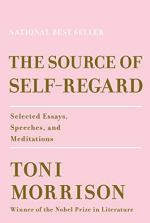
|
| Name: _________________________ | Period: ___________________ |
This test consists of 5 multiple choice questions, 5 short answer questions, and 10 short essay questions.
Multiple Choice Questions
1. In her "James Baldwin Eulogy," Morrison makes an allusion to what Biblical story?
(a) David and Goliath.
(b) The destruction of Solomon's temple.
(c) Leviathan.
(d) The visit of the Three Wise Men to the Christ child.
2. In "The Site of Memory," what tactic does Morrison point out in slave narratives?
(a) Engaging the audience through vivid description of slavery's brutality.
(b) Challenging the audience with frequent, pointed rhetorical questions.
(c) Creating audience sympathy through obvious appeals to pathos.
(d) Appealing to audience by assuming the reader's nobility and morality.
3. In "Unspeakable Things Unspoken," Morrison notes that she almost titled the essay something else--what?
(a) Cannon Father.
(b) Canon Father.
(c) Cannon Fodder.
(d) Canon Fodder.
4. In "Rememory," Morrison complains that a racist society has what effect on her as a writer?
(a) It makes her feel burdened by her Blackness.
(b) It prevents her from being honest.
(c) It makes her question her talent.
(d) It hobbles her imagination.
5. In "Grendel and His Mother," Morrison notes that Beowulf is a part of Western literature's characterization of evil as what?
(a) Pervasive.
(b) A product of environment.
(c) Feminine.
(d) A philosophical construct.
Short Answer Questions
1. In "God's Language," what does Morrison say is the place of religion in African American culture?
2. In "The Trouble with Paradise," Morrison says that writers must hold "an unblinking gaze into the realm of" what?
3. In "Chinua Achebe," Morrison says that she learned what from Achebe?
4. In "Introduction to Peter Sellars," Morrison says that Sellars wanted what kind of introduction?
5. In "Unspeakable Things Unspoken," Morrison says that arguments against the inclusion of African American writings in the canon follow a sequence that ends with what belief?
Short Essay Questions
1. In “Tribute to Romare Bearden," Morrison praises Bearden's work as a dialogue between artists; how does she see his work impacting her own?
2. In “Rememory," Morrison describes her writing process using memory and explains how it is similar to a thematic and narrative element in one of her books. What is her process, and which book's narrative does she see it reflected in.
3. According to “Goodbye to All That: Race, Surrogacy, and Farewell," what have been the changes over time in the literary handling of relationships between women of different races?
4. In “The Trouble with Paradise" what reasons does Morrison give for leaving the racial identification of those in the Convent ambiguous?
5. In “Introduction of Peter Sellars," what are the main points of Morrison's praise for Peter Sellars as an artist?
6. In “The Site of Memory," what reasons does Morrison give for finding her inclusion in an anthology about memoir to be both strange and appropriate?
7. What point is Morrison trying to illustrate when she brings up the origins of Ancient Greece in “Unspeakable Things Unspoken"?
8. In “Grendel and His Mother," what does Morrison say is interesting about the Danes' reaction to Grendel, and what does she say this shows about the nature of evil?
9. In “Memory, Creation, and Fiction," what Black cultural aesthetic expectations does Morrison discuss as important in her work, and why is it important to her to use them?
10. In “The Source of Self-Regard," what does Morrison describe as some of the contradictions that jazz contains?
|
This section contains 1,081 words (approx. 4 pages at 300 words per page) |

|




